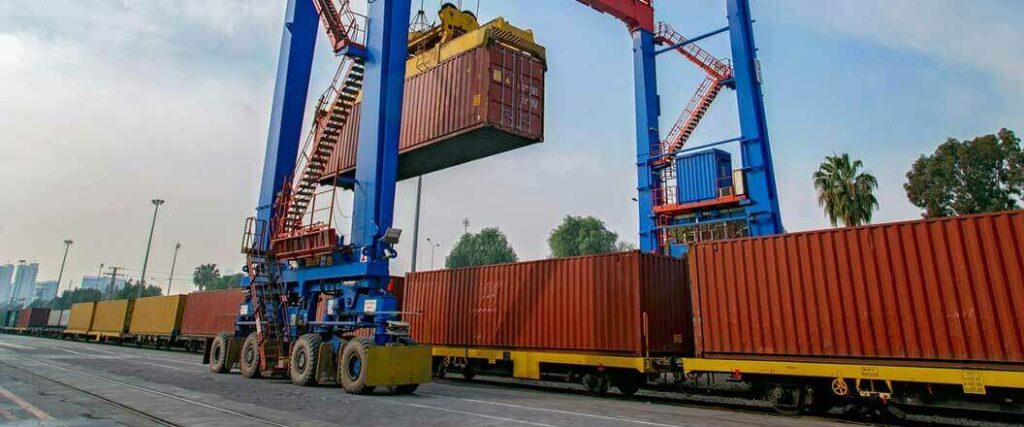The Association of American Railroads describes Standard Transportation Commodity Codes (STCC) as a unique 7-digit sequence used to classify commodities that are moved by rail and truck. These numbers streamline the shipping process, ensuring accurate transportation, tracking, and effective transload operations for shippers.
Without an STCC, shipments can face numerous challenges, like misidentification and delays in transporting or receiving cargo. Learn more about these codes in our comprehensive guide on the topic.
What Are Standard Transportation Commodity Codes?
STCC codes are identifying numbers for freight. The seven numbers in the code are presented as two digits, a space, three digits, another space, and the final two digits.
Each group of numbers represents the following:
- Digits 1 and 2: The beginning two numbers denote the major category of the commodity.
- Digits 3–5: The three numbers in the center provide more details of the product, such as the material, form, or specific type.
- Digits 6 and 7: The last two numbers provide more specific information about the processing of the product or other characteristics not explained by the previous digits.
Essentially, each number grouping in the STCC code further narrows down the classification of the freight that’s being transport. The first set of digits are the broadest level, while the final is the most detailed.
Information provided by STCC commodity codes are used on waybills and other transportation documents. It’s also used to determine shipping rates that businesses will have to pay.
While STCC codes are used for truck transport, they’re especially important for rail shipping. To show how often this system is used, consider the volume of train cargo over the past few years.
Volume of Rail Freight Transported In Billion Tons(2018-2022)
| Year | Amount of Rail Freight |
| 2022 | 2,239 Billion |
| 2021 | 2,241 Billion |
| 2020 | 2,105 Billion |
| 2019 | 2,364 Billion |
| 2018 | 2,523 Billion |
Provided by Statista
Rail freight volumes have largely stayed in the same two billion ton range over the past few years. For just about every shipment, STCC codes are used to classify the cargo that’s being transported.

What Are the Benefits of Using Standard Transportation Commodity Codes?
Standard Transportation Commodity Codes aren’t legally mandated for shipping. However, they are highly recommended for efficient logistics operations. Many large carriers and logistics companies adopt STCC as a standard practice due to the numerous benefits they offer in tracking and managing shipments. We’ll unpack each one and explain them in detail.
1. Streamlining Logistics Operations
STCCs significantly streamline logistics operations. The structured system of classification brings a level of efficiency and clarity that is essential in the fast-paced world of shipping and transportation.
These codes help streamline logistics in the following ways:
- Facilitating easy categorization
- Enhancing tracking and monitoring
- Improving efficiency in handling and processing
- Aiding in regulatory compliance
Each unique code corresponds to a specific type of good, simplifying the process of sorting and handling different items. This is particularly useful in transloading facilities where goods are transferred between different modes of transport.
Since each commodity is assigned a specific code, logistics companies can quickly identify where an item is in the supply chain. From there, carriers can assess the status and predict delivery times more accurately.
Efficient handling and processing of goods is critical for any logistics operation. STCC codes streamline these activities by providing clear guidelines on how different commodities should be treated.
STCC codes aid in compliance as well. The clear definition provided by these numbers make it easier to process and report information to regulatory bodies.
2. Improved Communication In the Supply Chain
Standard Transportation Commodity Codes provide a universal language for classifying commodities.
This helps improve communication in the following ways:
- Facilitating accurate information exchange
- Enhancing coordination among different parties
- Reducing delays and discrepancies
Accurate and efficient exchange of information is critical in logistics. STCC codes allow for precise and unambiguous descriptions of goods, ensuring that all parties are on the same page regarding what is being shipped.
Coordination is essential in logistics. The universal language offered by STCC codes ensures everyone transferring a shipment from one mode of transport to another is on the same page.
Communication breakdowns can lead to delays and confusion. With the implementation of STCC codes, there is a significant reduction in such issues.
3. Accurate Pricing
Businesses moving cargo don’t want to spend more money than needed, and want as much pricing accuracy up front as possible. Thanks to the accurate description of cargo provided by STCC, carriers can give an accurate rate that will need to be paid to move the shipment.
This is especially critical when transloading bulk freight between modes of transport. Similarly, transportation companies don’t want to under charge for shipping, or they’ll end up losing money. STCC codes ensures they charge a rate that’s fair for their customer, but also high enough to cover their costs.
Check out our article on consolidated freight costs to learn about the expenses of this service.
4. Optimizes Warehouse Management
The integration of Standard Transportation Commodity Codes into warehouse management brings significant optimization and efficiency.
This includes:
- Efficient storage and retrieval
- Enhanced space utilization
- Reduced handling errors
With STCC categorization, the storage and retrieval processes become more streamlined. Warehouse staff can quickly identify where a particular item should be stored based on its code.
Effective warehouse management involves maximizing space utilization. Workers can get an idea of how large freight will be based on the description provided by STCC codes. As a result, they can make space for the goods they’ll receive.
Since the STCC commodity code list communicates the type of goods that will enter a warehouse, workers will know ahead of time how to handle each shipment that comes in.

How Do I Find My Standard Transportation Commodity Codes?
Shippers have to find the right standard transportation commodity codes to move and transload freight. Fortunately, there are a few methods they can use to find the information they need.
Consult the STCC System
If shippers want to find their Standard Transportation Commodity Code, they can consult the STCC system. This is the source that has all the codes used in logistics operations.
The STCC code list can be found on sites run by organizations that are authorities on logistics and transportation. Shippers will just have to work their way through these codes until they find the one that best describes their freight.
Use An Online STCC Finder
A quicker way to work through the list of STCC codes is to use a finder tool. Rather than working through an entire list, this method will help shippers narrow down their results much faster. As a result, businesses can more easily find their respective Standard Transportation Commodity Code.
Multiple finder tools can be found online, but each one functions differently. Oftentimes, shippers will have to put in the name of their commodity or search for a category they think their freight is under.
Get Your STCC with Transload Services USA
If you’re struggling with Standard Transportation Commodity Codes, then Transload Services USA can help you out. The professionals on our team have many years of experience navigating these pesky codes.
We can also help with other services, such as:
- Cross Docking: Efficiently transferring your cargo from one transportation vehicle to another.
- Freight Rework: Addressing any issues that arise during transit, ensuring your goods reach their destination in perfect condition.
- Freight Consolidation: Combining shipments to save you time and reduce costs.
Shipping fast, combining loads, and reworking freight doesn’t have to be a hassle. With Transload Services USA, you’ll be in safe hands. If you’re ready to use our services to enhance your shipping experience, then call our team at (352) 282-4588 or fill out your quote.


